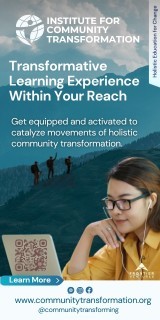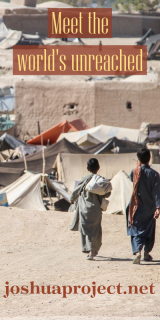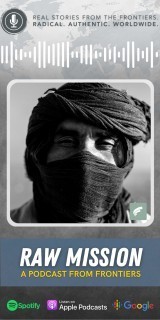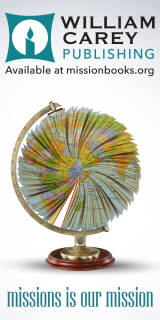This is the U.S. Center for World Mission

Before you get lost in the next few pages which picture he various subdivisions of the U.S. Center for World Mission what do you think the USCWM really is?
A school? (It does include a university.)
A think tank?
A mission agency?
A cooperative center? (It is all of the above.)
This letter will give you a helicopter view of the next few pages!
Dear Jim,
Your question should be easy to answer, but It Isn't, simply because there Is nothing else in the world quite like the U. S. Center for World Mission. "What Is it, then?" you ask. Let me see if I can explain.
What is the USCWM?
First of all, it Is the only major center in the world where many mission agencies can work together. After eight years, 300 full tIme people from 70 mission agencies work here shoulder to shoulder every day. All of them focus exclusively on making sure that the 17.000 people groups still unreached with the gospel will have a chance to hear.
The USCWM (as we call iti is virtually self sustaining, needing only to complete payment on the property itself because the individuals and organizations using these facilities seek their own support. Our top officials receive the same pay as the youngest missionary on staff.
"What does it look like?" you want to know. Let's see. The property Is a 35 acre former college campus, including 13 campus buildings and 83 offcampus houses, worth altogether about $20 to $25 million. We still owe $8.5 million, which is due next September, a year from now (plus quarterly payments of $300,000 in between).
I can just hear you say, 'Oh, you are just one more good Christian organization." Well, you're wrong there. But be patient as I explain why.
Why is the USCWM?
Do you remember the Lausanne Congress on World Evangelization which Billy Graham called In 1974? Christian leaders 2100 of them came from all around the World. Well, Dr. Winter gave one of the main addresses there, and the opening audiovisual on the Unfinished Task was based on an article he had written. At that time Dr. Winter was a seminary professor of missions (after serving for ten years as a missionary to Indians In Central America).
The thing that troubled him at Lausanne (and afterward) was the feeling that although many were interested In the unreached peoples, few were making unreached peoples their main concern. Church leaders, and even most missionaries, It seemed, were very busy doing other important things. And Dr. Winter felt that unless someone did something drastic, nothing much would change.
For two years after that meeting in Lausanne he prayed about his concern and discussed it with many other Christian leaders. But ultimately he and his wife felt Irresistably called by God to take a step of faith that left them land many others) breathless.
The task to be done was huge. They knew that to arouse the nation to their cause, and to define it more precisely, would take a lot of help. They would also need a lot of space so that personnel from many mission agencies could work together.
Where Is the USCWM?
A small college campus was for sate in Pasadena, It would be ideal. It was at luxurious; It was accessible from the Los Angeles International Airport; Southern California represented a veritable Pentecost' of nations (107 languages In the home of public school students) and nowhere else were so many mission agencies concentrated. But how in the world could he and his wife land a handful of missionaries) acquire a property worth millions of dollars?
What happened next Is a fascinating story of tests and miracles as told by Roberta, Dr. wife and coworker. In 'ONCE MORE AROUND JERICHO." This book has just been updated under the title 'THE KINGDOM STRIKES BACK: THE SECRET MISSION.'What People Soy.
It's amazing how God has used the Center from Its very beginning. Leaders like Billy Graham have commented on its strategic role.
But it is the missionaries who are most excited. Dr. Vergil Gerber, for example, for some years head of the joint information office of the two largest associations of mission agencies in the world, said, "The establishment 0f the U.S. Center Is one of the most significant events In world missions In our generation." And Dr. Jack Frlzen, Executive Director of the interdenominational Foreign Mission Association, visited us here and wrote back later, 'I had no idea of all you are doing. The Lord won't let you lose this campus; it is just too important to she cause of missions!'
I know how skeptical you are. You're probably saying. 'Now wait a minute! There are all sorts of mission agencies doing all sorts of wonderful things. What specifically Is happening at the U.S. Center for World Mission that Is so strategic and different?
What People See
Well, let me take you on a quick tour! You'll notice first of all the buildings. They aren't elaborate. Some are even a bit 'old fashioned" as college campus buildings go these days, but if we had to build them from scratch well, we never could afford it. That's what!
Most people comment next on the close community atmosphere. We live and work and pray together, are all living on the same salary level and, like most missionaries, "raise our own support" from churches and friends. That's why we can operate with low overhead. But that's still not what is so unique.
One article written about the USCWM called it a Pentagon of mission strategic thinking, Why?
Let's look at the four major divisions of the Center.
First and foremost is our Division of Mission Strategy headed by Ernie Heimbach, who is on loan to us from the Overseas Missionary Fellowship. People in this division are, in effect, REACHING OUT to the lost world, trying to find out for the b.nflt of Christians around the globe exactly what needs to be done.
Researchers, cooperating with MARC and other offices are zeroing in on the 17.000 Unreached People Groups the Hidden Peoples, as they are called getting to know them group by group. The information they find they pass on to the mission agencies. We hope soon to have a computerized networking system which will make this transfer of information automatic and very efficient.
Our second major department, the Division of Mission Mobilization takes what we're learning in the Strategy Division and REACHES BACK with Inspiration and vision to the church in America.
Mobilization produces all sorts of materials for use in churches, Sunday Schools, campuses and homes. It encourages Christians in America to back their mission agencies more faithfully, to pray daily for the Unreached Peoples and to send their young people as missionaries.
You've heard about the nationwide Frontier Fellowship Movement? It's our Mobilization Division which produces the Global Prayer Digest for the Frontier Fellowship. More about that later.
Also, we have begun to form a network of field representatives across the United States who will ensure that people in churches and on campuses have access to these materials and programs.
The Strategy and the Mobilization divisions are what you might call "action" departments. We also have two supporting divisions. Our Training Division, for example. Includes the William Carey International University which for some years has had authorization to grant the B,A., the M.A. and the Ph.D. degrees."Why should a mission organization run a university?" you ask? I'm sure It must seem odd. You'll have to read the Training Division report "Crowing Up In America' further on.
Let me Just say here that if the unfinished task of missions is to be dealt with seriously, some changes are going to have to be made in the basic education of our Christian young people. We get so used to doing things the same way that we don't see what could be done . especially what could be done if the mission industry itself controls the university,) It's exciting!
Then, besides Training, our other supporting division is the Division of Mission Services. Here we offer technical services to all mission agencies, ranging from printing, graphics and publishing to computer science, mailing list management and film dubbing you name it!
But look, I don't want to tell it all. You really should come to see us. But until you do, take a tour with me in the following pages. Will you? Our first stop is the Strategy Division ....
Developments Within The Strategy Division of the USCWM
It is exciting to see what the various strategy institutes at the USCWN have accomplished In lust a few years. From the founding of the Center In 1976. the objectives of the Strategy Division have been fourfold, as follows:
- to assist in the discovery and varlficatlon of each unreached people group
- to suggest strategies for penetrating and planting indigenous, evangelizing churches among them
- to share information and suggest strategies with evangelical missionary agencies and churches; and
- to encourage and assist them in reaching these peoples
Although various of the central offices of the U.S. Center for World Mission are constantly involved in strategic research and thinking, most of the detailed research Is done by various cooperating agencies on campus, which we call the 'Strategy Institutes." These are separately incorporated and are administratively and financially independent from the USCWM even though they work In close harmony, meeting together on a regular basis under the auspices of the Center inseif to pray and share information.
The various strategy Institutes are listed below in the order in which they joined the USCWM complex. Their technique of operation varies, as can be seen by the reports of activities which each one has submitted below. Agencies are encouraged to contact them directly at the USCWM address for any information which is needed.
Institute of Chinese Studies
- Regions of the Peoples Republic of China (map)
- Watchman on the Great Wail (prayer profiles)
- Extended Family (occasional bulletin detailed profiles on unevangelized Chinese people groups worldwide)
- ICS news bulletin
- Bilingural Literature (evangelistic in content) a People Groups of Mainland China (wan map) * Consulting Services
- Monitoring of all the periodicals that come out of the Peoples Republic of China
- Chinese Awarness Seminars (for presentation in churches)
Institute of Native American Studies
- a Listings and field motes on indian reservations with no existing Indian church (10% of reservations surveyed to date have no indigenous church among them)
- initial surveys of Indian urban populations in the U.S.
Institute of Tribal Studies
- Area statistics for North Africa and SubSahera Africa
- People profiles: Gabbrs, Turkana. Eastern Pokota. Orma, Samburu, Rendilie. Camoriens, Muslims of Lansu, Niemp, DIgo, Katuka, Taposa, Herero, Xaiash, Degodla, Burmese inthe, Dobe, Kung.
- Country profiles
- Lists of missionaries (categorized according to occupation and availability for research)
- Seminar material.
- Consulting Services
Institute of Hindu Studies
- Entry/visa possibilities
- Maps (various statistics and unreached groups)
- Bibliographies
- Introductory course on Hinduism
- Prayer profiles for unreached peoples Lists of indigenous mission agencies and leaders
- Seminar materials
- Consulting Services
Samuel Zwemer Institute (Muslim Studies)
- Library Number of course offerings at MCII) and Fuller Theological Seminary
- Theses, papers, from over 600 students from 53 different mission agencies
- Slide library on Muslim Peoples
- Slide tape series on Muslim Peoples
- Muslim Tribes in Africa (map)
- Muslim Awarness Seminar
- Seminar materials (overhead transparencies)
- Local outreach training program
- Consulting Services
Institute of Japanese Studies
- Mission boards working In Japan
- Names and addresses of missionaries working in Japan
- Needs of ministry opportunities in Japan
- Church planting methodologies in Japan
- Contacts with key information resources in Japan
- Course offerings: 'The Gospel and Contemporary Japanese society', 'Effective Evangelism In Japan'
- Consulting Services
Global Mapping Projects
- Selected maps (African languages, Kenya, Guatemala)
- Selected computer reports on status of church, peoples, etc.
- Ethnoiogue 84 (on computer language listing)
- World Data Bank ii Call country boundaries, cities, rivers of the world) Research Data Guides
- Complete Country and Province profile, (including coding) of the world
- Recorded language directory of Gospel Recordings on computer 1600 people profiles
Scriptnet
- Christian Booksellers List (bookstores in Greater L.A. area which sell Bibles and other christian literature in foreign languages)
- India Calling LA (kit for those involved in South Asian ministries including churches and fellowships using Indian languages)
- Ethnic Churches list for greater L.A. area
- 5 Foreign Bible distributor lists
Future plans exist for an institute of Buddhist Studies as well as an institute of Urban Studies.
The Many Thrusts of the Mobilization Division
The Mobilization Division is our second "action" department. Its main objective is to mobilize the church in America for a massive thrust out to the final frontiers. Whereas the Strategy Division faces toward the world and the unfinished task, the Mobilization Department faces toward the church and the agencies which must do that task. Whatever ii takes to mobilize the church for mission to the frontiers, then, is the responsibility of the Mobilization Division.
Every mission agency informs its own constituency about its work and its goals. The USCWM in its Mobilization Division, however, informs the Whole church (all denominations and every mission agency) about the whole job of unreached peoples. Mobilizing is one of the most important things that the USCWM does. Unless the church backs the agencies with prayer, finances and recruits, all the research done in the world will accomplish nothing,
How does the USCWM mobilize?
- Through cooperating mobilization offices which reach into specific church constituencies. (These are listed below.)
- Through the Frontier Fellowship movement, headquartered here.
- Through our Extension Ministries Department.
Frontier Fellowship, Inc
Perhaps the most visible mobilization office is that of the Frontier Fellowship Movement. The Frontier Fellowship was born at the USCWM, and all its materials are produced here. Its goal is to mobilize a million North American Christians in a prayer campaign with five basic disciplines:
- daily prayer for unreached peoples;
- daily reading about them;
- saving loose change for frontier outreach;
- meeting together regularly with others concerned for the unreached peoples;
- and sharing the frontier vision with others.
The Frontier Fellowship works in cooperation with a large number of churches, denominations, mission agencies, schools, and other Christian organizations for whom it produces a number of frontier mission prayer resources, curricula, and activity guides.Key items already in production include the monthly prayer guide, the Global Prayer Digest (now in over 20 customized editions); the FrontierScan bulletin insert; and Focus, a newsletter for mission mobilizers.
A Frontier Fellowship "How To" guide is in the final stages or development, as Is an "Unreached Peoples Sunday" Kit, designed to provide a professional quality presentation of the needs of unreached peoples and list the resources that are available to the local church.
The Frontier Fellowship expects soon to be incorporated as an independent entity, although the materials it offers will continue to be produced at the USCWM, with the help of the various strategy institutes and other mobilization offices.
What Do You Mean by Extension Ministries?
The Extension Ministries Department has many of the same goals as the Frontier Fellowship, but is essentially the Center's attempt to minister to those with whom It is in direct contact. It does this through three distinct offices: the Extension Ministries Program. Extension Ministries Correspondence, and the Extension Ministries Network. Extension Ministries Program.
Initially begun as a fund raising office, the Extension Ministries Program (EMP) office is the "sales" arm of the U.S. Center for World Mission.
It has the task of developing materials and programs that will sell to the American evangelical church both the mission vision and the programs of the U.S. Center for World Mission.
EMP seeks to ensure that, whenever an appeal is made to help pay for the Center campus. there is always a proclamation of the Center's vision. Its goals, its reason for being.
In other words, attempts are always made to nurture the frontier mission vision and activity of persons who give to the Center.
EMP has been responsible for developing, implementing, and refining the Touch Ten campaign, Hidden Peoples Parties, and other programs. It has also been Intimately Involved in the development and refinement of various pamphlets, articles, and media presentations about the Center and the Center's vision and goals.
EMC Extension Ministries
The purpose of the Extension Ministries Correspondence (EMC] office is to nurture a frontier mission vision and involvement in everyone who corresponds with the Center not only those who give to the Center, but everyone who contacts the Center. for any reason whatsoever.
Each USCWM staff member is an "Area Coordinator" of a state or region in the U.S. Area Coordinators answer all correspondence received by the Center from persons within their assigned areas.
Coordinators seek to establish personal relationships with correspondents and, through these relationships, to hurture correspondents in frontier missions activity.
For personal edification, correspondents are encouraged to subscribe to the Frontier Fellowship Global Prayer Qjt, or to study the "Perspectives on the World Christian Movement" course.
In order to involve their friends and relatives in missions, correspondents are urged to form Frontier Fellowship groups, or to host home slide presentations such as those used for the Hidden Peoples Parties.
Our computerized recordsprocessing system is now being expanded to provide Area Coordinators with all the background Information we can elicit about correspondents' mission involvement, training, and interests. Such information helps Area Coordinators to more effectively nurture those with whom they correspond.
EMN Extension Ministries
Founded in the summer of 1984, the Extension Ministries Network (EMN) office Is relatively new to the USCWM. Its purpose is to provide assistance to people "out there" who have a special interest in spreading frontier missions vision within their church fellowship, or to friends and neighbors, and to other churches in their area.
At present, the EMN offers three kinds of assistance.
Resource Referrals: to those who request such aid, the EMN will recommend specific publications, audio visuals, agencies, or other resources and/or resource suppliers to meet their vision spreading needs.
- Training: practical guidance in establishing strategies for spreading vision, making contacts, and discipiing Christian, in mission activism.
- Support: as mission mobilizers gain skills and acquire experience, "networking" comes into play. Knowledge is shared between them by means of regular communiques. Further, prayer and other forms of practical support are encouraged.
Additional forms of assistance will be offered as needs are identified.
Cooperating Agencies of the Mobilization Division
As is true with the Strategy Division, there are a number of other, cooperating, agencies on campus which reach out to mobilize their own specific constituencies. For example, the Chinese World Mission Center touches all the Chinese churches in North America. inspiring them with vision about the frontiers and encouraging their young people to become frontier missionaries, Me hope eventually to have a cooperating mobilization office for all the major streams of Protestantism, and are in consultation with several right now.
Those presently on campus not only mobilize, but many also give classes specifically related to their expertise. They are as follows:
- Chinese World Mission Center
- World Christian, Inc.
- Caleb Project
- Fellowship of Artists for Cultural Evangelism
- Mission SOS (Swedish)
- Overseas Counseling Service
- Episcopal Church Missionary Community
- United Presbyterian Center for Mission Studies
- Also on campus is the regional office of Africa Inland Missions, the headquarters office of Frontiers a new, rapidly growing mission agency and an active representation of RBMU and Overseas Missionary Fellowship







comments